Today, the tiny Scottish island of Iona is not the easiest of places to get to. It’s a long drive across the Isle of Mull to Fionnphort from the main ferry link with the Scottish mainland at Craignure. However, in the past Iona was the centre of Christianity in the region, as well as being a site of political significance. Travelling by boat, it was easier to reach than its geographical isolation suggests.
I visited the island on a mild September day, after a long drive from the eastern coast of Mull. The sea was clear and calm and made for a smooth passage on the short ferry trip from Fionnphort; later on a pod of dolphins could be seen in the Sound of Iona. It is a peaceful place, with beaches of white sand and outcrops of pink granite. Since the 7th Century it has been a place of pilgrimage, and it continues to welcome thousands of visitors every year.

Up the hill from the ferry drop-off and the houses is a site that’s been a place of pilgrimage for 1400 years – Iona Abbey, which was originally founded by St Columba, or – to use his Gaelic name – Colum Cille. A political exile from Ireland, Columba had founded Iona Abbey in 563 with companions who had accompanied him from Ireland. Nothing remains of this first abbey – it was a simple, austere structure that has long since disappeared to be replaced by grander stone buildings. During his lifetime, Columba was highly respected and seen as a figure of both religious and political significance. As a literate and well-educated man, Columba was able to act as a diplomat between the various tribes of northern Britain. He is also credited with helping to spread Christianity in Scotland, which at the time was mostly pagan.

Columba’s influence continued after his death in 597. His burial place was visited by pilgrims and the monks of the abbey were at the centre of learning in the Gaelic-speaking world. It was on Iona that the famous Book of Kells was created before it was moved to Ireland. Exiled princes sought refuge on Iona and the pious and powerful sought to have their final resting place as close as possible to that of Columba.

Very few people were ever awarded the honour of being laid to rest close to Columba himself. Other than abbots of the abbey, those who were laid to rest on Iona were taken down the “Street of the Dead” that led from the abbey to the nearby burial ground of Rèilig Odhrain.


It’s possible that there have been burials here since the time of St Columba himself. The small chapel that stands in the burial ground is dedicated to St Oran (also known as Ódhrán) and is thought to be the oldest church still standing on Iona. Oran was one of St Columba’s original companions when he first founded the abbey on Iona, and was apparently the first of the companions to die there, in 548. It is said that St Columba had a vision of Oran’s soul ascending to heaven after being fought over by angels and devils. A grisly legend endures about Oran’s death – the story goes that Columba was building a church that kept being destroyed. Columba heard a voice that told him the church would never be finished unless a man was buried below it, and Oran volunteered to be buried alive to enable the church to be completed. This dark tale is not included in Adamnan’s Life of Columba, which was written only a few years after Columba’s death and by a man who knew him well. It does however have parallels with the tale of St Odran, the first Irish martyr, who was killed in the 5th Century. This Odran was a disciple of St Patrick, and willingly gave up his life in order to save the life of Patrick.

It’s thought that the beautiful Romanesque doorway of St Oran’s chapel was added in the 12th Century, possibly during the reign of the Norse-Gaelic king Somerled (d. 1165).
A document from the 16th Century claimed that a number of kings – 48 Scottish, 8 Norwegian and 4 Irish – are also buried at Rèilig Odhrain, although there is no definitive proof of this. However, the quality of the many medieval grave slabs from the site shows that a large number of high status individuals were buried there. The best examples of these gravestones are no longer in situ – in order to protect them from the elements they have been removed to the little chapel of St Oran or to the Abbey’s cloister, where they adorn the walls. It’s a shame that these graves are no longer in their original positions, but moving them has allowed the beautiful carvings on the stones to be preserved.

What immediately struck me about these memorials is the lack of religious symbolism on them, despite their location so close to a shrine. Instead, the beautifully carved stones give us an insight into how the powerful men of the Scottish Isles (and perhaps a bit further afield too) wished to be seen.
A number of the stones depict long swords, clear symbols of martial prowess.
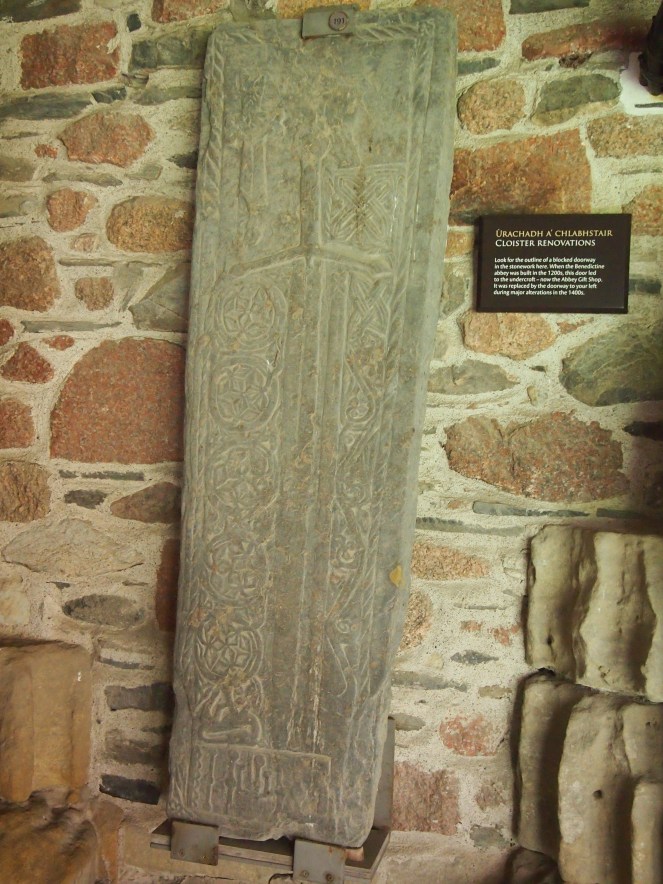
Another common symbol is that of the ship – the gravestone pictured below is thought to be that of Aonghas Óg MacDomhnaill, a member of the powerful MacDonald clan who died in the 14th Century. The ship on the gravestone symbolises his power as a Hebridean lord – in order to retain control over the islands, he needed to have command of ships and fighting men. He was an ally of Robert the Bruce and a descendent of Somerled, who had been King of the Isles in the 12th Century.

The Hebrides, where Iona is located, did not become a part of the Kingdom of Scotland until 1266. When Columba founded Iona Abbey in the 6th Century, Iona was part of the kingdom of Dál Riata and after the Viking raids and invasions from the 9th Century onwards was part of the Kingdom of the Isles, which endured until the Hebrides became part of Scotland. The history of Iona in the centuries after the Viking raids began is fragmented and patchy, as the monastery declined after being sacked more than once in the early 800s and detailed records were not always made.
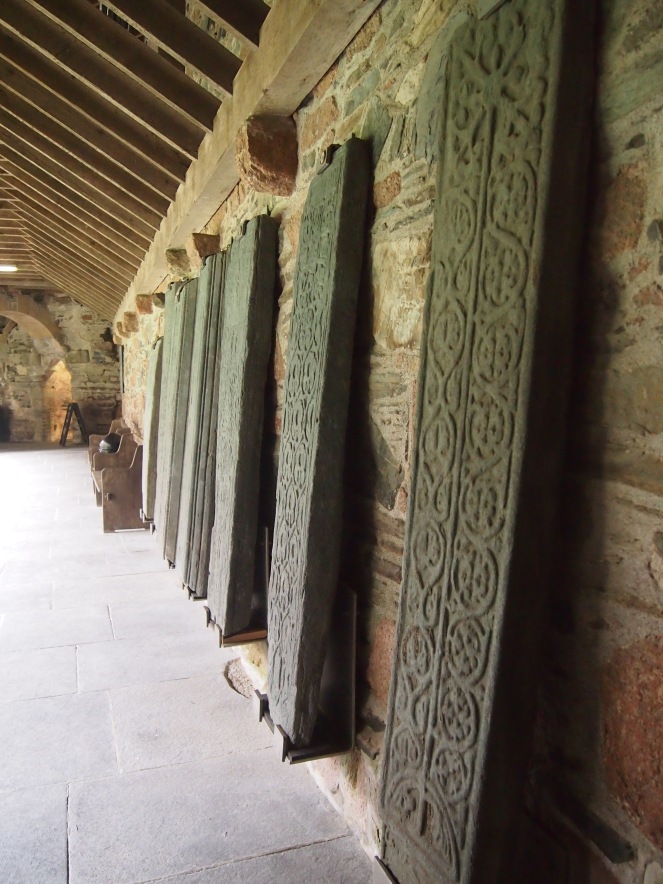
Sadly, very few of the beautifully carved memorials can be linked with named individuals – the gravestone of Aonghas Óg MacDomhnaill is an exception. Many of the gravestones do not have any inscriptions on them. At a time where the ability to read was unusual (even some lords and kings were illiterate), a memorial with high quality carvings and recognisable symbols of power, such as the sword and the ship, would have made more of an impact on those viewing the graves.
The most spectacular memorials are found in the little museum behind Iona Abbey. Dominating the museum are the rebuilt fragments of the huge stone crosses, which in the dimly-lit building I found quite awe-inspiring. Iona was once home to many of these crosses, but some have been lost altogether and others only survive as broken fragments. St Martin’s cross, pictured below, is a remarkable survivor – it still stands outside the abbey, 1200 years after it was first erected there.


The museum also contains some beautiful effigy graves of some of the high status individuals buried at Iona. Most of these effigies depict warriors – powerful clan chiefs and heroes, dating from about the 14th Century all the way up to the 16th Century, when the abbey was dissolved as part of the Protestant Reformation. One remarkable memorial depicts a prioress – a rare surviving image of a woman. Anna McLean, who died in 1543, was prioress of the nunnery close to Iona Abbey, and was commemorated by an ornate gravestone. Photography wasn’t permitted in the museum, but this webpage has some great images and further information about many of the effigies and other items exhibited there.
A number of older grave slabs remain in the cemetery, lying alongside more modern burials. These old memorials are generally worn and illegible today. The clean air provides the perfect environment for mosses and lichens to grow, which has further obscured many of the gravestones in Rèilig Odhrain.
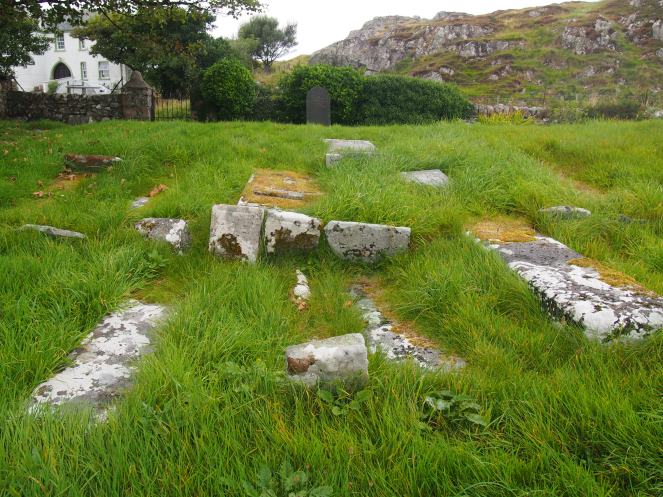
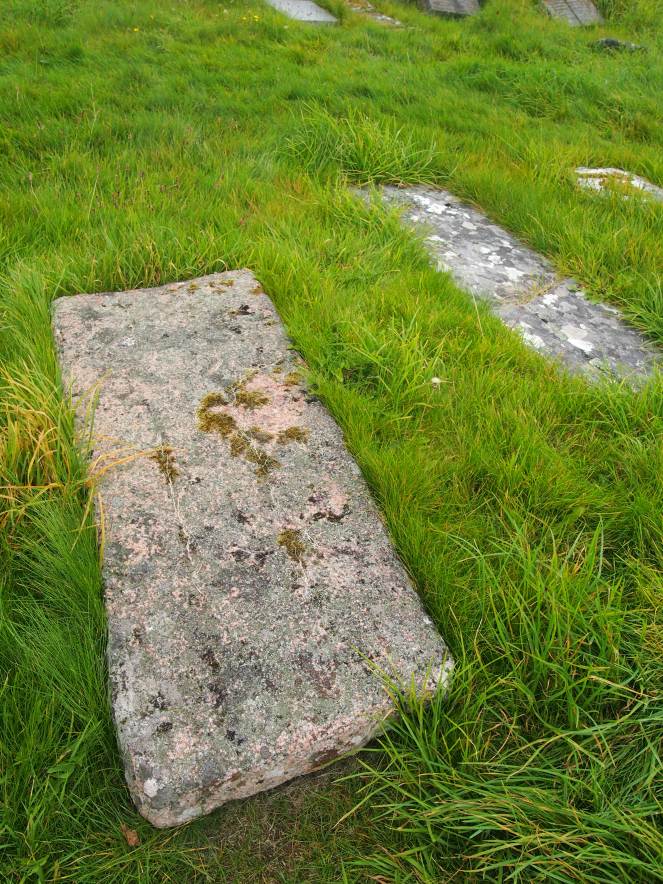

Samuel Johnson and James Boswell visited Iona in 1773, as part of their travels through the Hebrides which they chronicled in the books A Journey to the Western Islands of Scotland and The Journal of a Tour to the Hebrides with Samuel Johnson, LL.D. Johnson was not particularly taken with Rèilig Odhrain – or the guide who showed them around – and questioned the tradition that kings were buried there.
A large space of ground about these consecrated edifices is covered with gravestones, few of which have any inscription. He that surveys it, attended by an insular antiquary, may be told where the Kings of many nations are buried, and if he loves to sooth his imagination with the thoughts that naturally rise in places where the great and the powerful lie mingled with the dust, let him listen in submissive silence; for if he asks any questions, his delight is at an end.
Iona has long enjoyed, without any very credible attestation, the honour of being reputed the cemetery of the Scottish Kings. It is not unlikely, that, when the opinion of local sanctity was prevalent, the Chieftains of the Isles, and perhaps some of the Norwegian or Irish princes were reposited in this venerable enclosure. But by whom the subterraneous vaults are peopled is now utterly unknown. The graves are very numerous, and some of them undoubtedly contain the remains of men, who did not expect to be so soon forgotten.

Boswell, not as grumpy as his companion Dr Johnson, had come to Iona with high expectations. Perhaps rather naively expecting a cemetery for kings to be as grand as the royal burials in Westminster Abbey, he found himself disappointed.
Early in the morning we surveyed the remains of antiquity at this place, accompanied by an illiterate fellow, as cicerone, who called himself a descendant of a cousin of Saint Columba, the founder of the religious establishment here. […]
But I must own that Icolmkill did not answer my expectations; for they were high, from what I had read of it, and still more from what I had heard and thought of it, from my earliest years. Dr Johnson said, it came up to his expectations, because he had taken his impression from an account of it subjoined to Sacheverel’s History of the Isle of Man, where it is said, there is not much to be seen here. We were both disappointed, when we were shewn what are called the monuments of the kings of Scotland, Ireland, and Denmark, and of a king of France. There are only some grave-stones flat on the earth, and we could see no inscriptions. How far short was this of marble monuments, like those in Westminster Abbey, which I had imagined here! The grave-stones of Sir Allan M’Lean’s family, and of that of M’Quarrie, had as good an appearance as the royal grave-stones; if they were royal, we doubted.

Resting in the cemetery is a couple whose work made helped to make Iona the heritage destination it is today – Alexander and Euphemia Ritchie. Both talented silversmiths, the couple set up home on Iona and produced jewellery inspired by the intricately carved Celtic and Viking designs they saw in the ruins of the abbey. They are credited with beginning the revival of Celtic-inspired jewellery, which still enjoys widespread popularity today. The Ritchies set up shop on Iona and their work was very popular. They were also well-versed in the history of the little island and in 1900, Alexander was appointed custodian of the abbey’s ruins. He worked as a guide at the site, showing visitors around and his encyclopaedic knowledge of the site was often consulted upon by those who began to restore the abbey in the 1930s. Alexander and Euphemia died within days of each other in 1941, and rather fittingly they rest close to the buildings and monuments that inspired their work for so many years.

Three unknown sailors from the Second World War also rest at Rèilig Odhrain, men from the Merchant Navy whose bodies washed up on the shore at Iona.
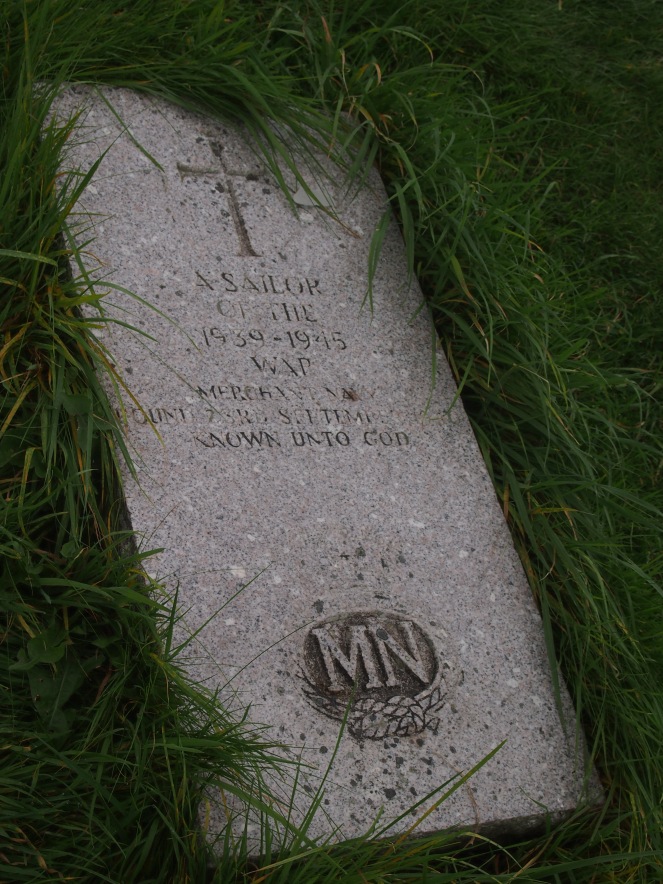
The most famous burial from recent years at Rèilig Odhrain is that of John Smith, the former leader of the Labour Party. His sudden death from a heart attack in 1994 led to the election of Tony Blair as party leader. Smith, a native of Argyllshire, had requested to be buried on Iona and his simple grave stone is still adorned by little trinkets left by well-wishers.

There are many gravestones of local people in the burial ground, with some of the monuments dating back to the 18th Century. By this time, Rèilig Odhrain had long since gone out of vogue as a burial place for the powerful – indeed, by this time the power of the clans had been severely weakened and Scotland had entered into a union with England. The more recent burials are haphazardly nestled in between older graves, the bones of Iona’s folk mingling with the dust of the Hebridean chiefs and warlords.



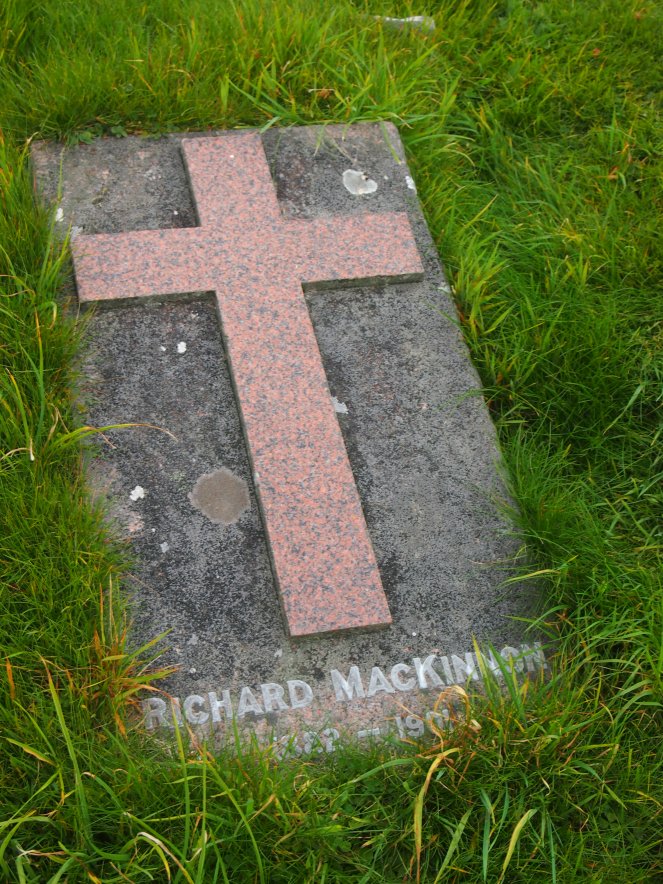
Iona can sometimes be dismissed as a “touristy” place but if the truth be told, it’s “touristy” for a reason. The burial ground at Rèilig Odhrain is next to the abbey, which was restored in the early 20th Century and today is home to a community again. For centuries it was an incredibly important place for spiritual and educational reasons and it’s well worth a visit. Now managed by Historic Scotland, the site contains a wealth of information about the abbey’s history and subsequent restoration, and highlights Iona’s importance in the history of the Hebrides. Rèilig Odhrain is a unique burial ground – it’s not often that graves from the early 20th Century are found alongside worn old medieval gravestones. Even if the stories about it being the final resting place of kings are untrue, it’s still an incredibly special place and rich in history. And if you’re lucky, whilst admiring the view from the burial ground over towards Mull, you might even see dolphins in the Sound of Iona.
References and further reading
Iona Abbey – Rèilig Odhrain/St Oran’s Graveyard http://www.ionahistory.org.uk/iona/ionahome/ionaexplore/ionaabbey/reilig.htm
Iona History – Carved Stones collection http://www.ionahistory.org.uk/iona/ionahome/ionaabout/ionadiscoveries.htm
A Journey to the Western Islands of Scotland, Samuel Johnson, 1775 (source)
The Journal of a Tour to the Hebrides with Samuel Johnson, LL.D., James Boswell, 1785 (source)
A brief history of the Ritchies http://www.alexander-ritchie.co.uk/history.htm
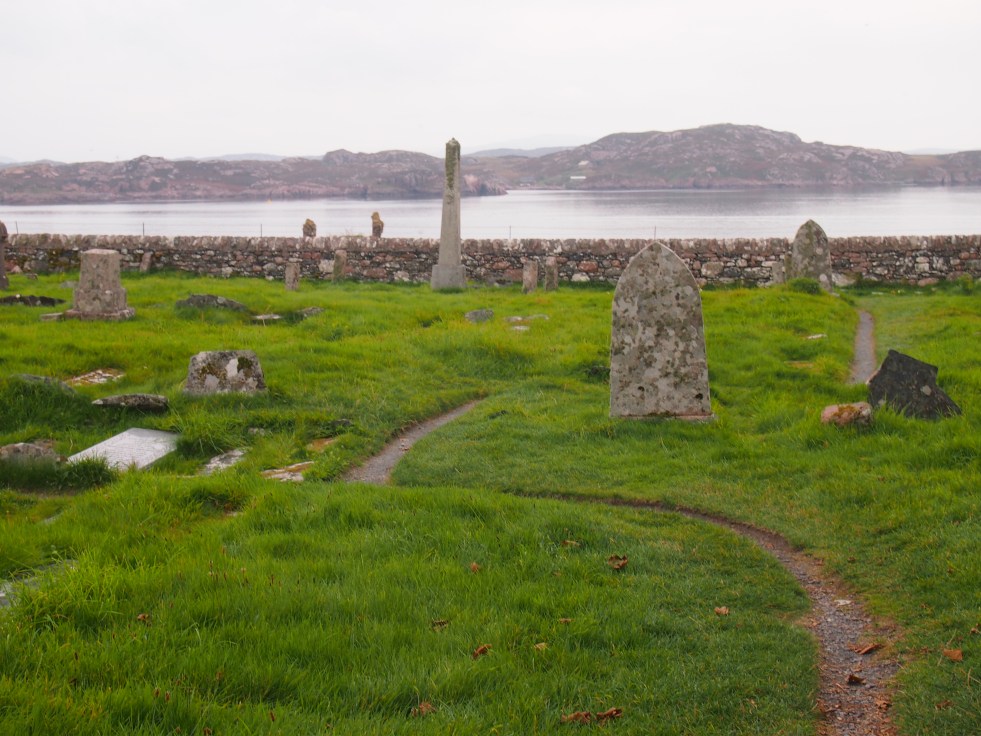

Oh, this post brings to mind our recent Twitter mini-discussion of much older/pre-Christian burial grounds! Rèilig Odhrain is far tidier in its layout than the graves past the abandoned fishing village on Inishkea, but looks to have the same feel of breathing, tangible antiquity. Well done!
By the way, as I was scrolling down and reading I glanced at the text under the reproduced painting of Samuel Johnson, and for some weird reason my brain decided to render the name to me as ‘Samuel L Johnson’. Now I shall forever be haunted by thoughts of the Great Cham peppering his deathless utterances with outbursts of ‘Motherfu…’ – for which I am eternally gratef-, I mean will blame you completely 😛 😛 😛
LikeLike
Samuel L. Johnson definitely needs his own comic strip, I think!
LikeLike
THIS. Right, who’s got Randall Munroe’s phone number? He has the right mindset. Or wait – Garth Ennis! Now there’s a man well familiar with the ‘Samuel L Johnson’ vernacular…:D
LikeLike
One of my most favourite places, Iona. We have visited twice and I have posted several times on the Island, to me it has a very magical calming influence, even with all the tourists 🙂 Lots of lovely information to read 🙂
LikeLike
Isn’t it a wonderful place? There’s quite a special atmosphere there, I can’t quite put my finger on what it is. But I really enjoyed my visit there and it was a real treat to find such an interesting old burial ground.
LikeLiked by 1 person
Yes everyone that visits the Island comes away with a special feeling, it makes me feel serene 🙂
LikeLike
There’s something enchanting about Scottish cemeteries. Visited a fair few about two weeks ago.
LikeLike
I know what you mean! They feel quite different to the cemeteries in London. I noticed that women tend to have their maiden names on their gravestones – not seen that before, but it was a feature of all the cemeteries I visited in Mull and Iona.
LikeLike
A really interesting post, I am very envious of your visit.
LikeLike
Thank you! I would definitely recommend visiting Iona if you’re ever in that part of the world.
LikeLike
A lovely description of my favourite place in the whole world! I was really interested to see the more recent grave stones as well. I always think they tell such sad stories. And beautiful photos. Aaargh, I want to stop work now and get on a ferry! 🙂
LikeLike
Thank you! It’s really not often you come across a cemetery with such a wide range of memorials – probably 1,000 years between the oldest and newest! It’s such a special place. I totally know what you mean about just wanting to go and get on a ferry… although it’s not the sunniest of days today!
LikeLike
I scattered my mother’s ashes there years ago, at the edge of the water. it was a very special moment, in spite of the fact that the wind changed and some of her blew back on me. I’m sure that made her smile.
LikeLike
What an incredibly interesting article – and photos! So much history. It’s very pretty. I hope one day I can visit there as well.
LikeLike
Thiis is a great post
LikeLike